Under The Sea 3D
Page 3 of 5
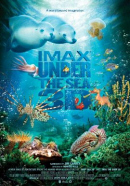
 Excerpt from Howard Hall�s Production Journal: January 11, 2008:
Excerpt from Howard Hall�s Production Journal: January 11, 2008:As I write this, we are at 30,000 feet, en route to Port Moresby, Papua New Guinea. Today is one year and three days since Michele and I began preproduction on this, our most ambitious IMAX 3D production ever. The logistics have been daunting. I can�t wait to get my hands on the ridiculously huge camera and slate it with brace #1. Soon I�ll be making that first dive and, for me, that�s what it�s all about.
Filmed with the incomparable scope and clarity of IMAX technology, "Under the Sea 3D" offers an intimate look into an underwater world few people have ever seen, and the exquisitely beautiful, sometimes treacherous and often comical creatures that live there.
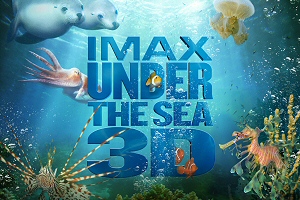
�Most people don�t even know these animals exist,� says director Howard Hall, a renowned documentary filmmaker and diver with extensive experience capturing marine wildlife on film. Hall, the first person to take an IMAX 3D camera underwater, in the 1994 feature �Into the Deep,� also serves as director of photography on �Under the Sea 3D.�
�In addition to Great White Sharks, you�ll see creatures like the Dwarf Minke Whale, the Chambered Nautilus and Big Fin Reef Squid. Our main goal in making these films is to bring animals that are little known, or not known at all, to the screen, to let people see how strange and wonderful they are. Plus,� Hall adds with a smile, �it gives me an excuse to go play in the ocean�� a passion he has been pursuing, and sharing, for more than 30 years.
With an aim toward protecting the ocean wildlife for future generations, Hall also believes, �People need a reason to care about coral reefs. My hope is that once they see these animals and realize that they�re not only remarkably beautiful but that they have their own interesting behaviors and personalities, they will fall in love with them and think it would be nice to have them around in coming years.
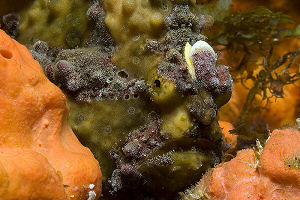
© Warner Bros. Pictures. A Warty Frogfish (Antennarius maculatus)
waits patiently for its next meal to swim by, as it sits
camouflaged in the temperate waters of New Britain, Papua New Guinea.
�There are many issues concerning the marine environment, certainly too many to cover within the context of one film,� he acknowledges. �On our previous film, we touched upon the importance of biodiversity; this time, we address the potential effect of climate change on ocean life.�
Taking it Further This Time
Having explored areas off the coast of California and the Baja Peninsula, North Carolina, British Columbia, the Gulf of Mexico, Hawaii and the Bahamas for �Deep Sea 3D,� Hall and his team wanted the new film to extend into more remote locales.
 Production Journal: October 15, 2008, Gunung Api Island:
Production Journal: October 15, 2008, Gunung Api Island:For those interested in looking at our location today on Google Earth, you probably won�t even see the island. This is a small rock less than a mile in diameter. It sticks up like one end of a football and that shape extends down into very deep water. There are only a couple of narrow ridges where we can put our feet down to work. Mostly the bottom is rubble or volcanic rock. Below one hundred feet, though, the invertebrate life becomes prolific and spectacular.
Says Hall, �For "Under the Sea 3D," we wanted to introduce audiences to some of the most exotic marine life, and that meant more distant and less accessible regions.�
�There are always more stories to tell,� adds Michele Hall, an avid diver herself as well as a wildlife photographer and producer for Howard Hall Productions, whose creative collaborations with her husband include �Deep Sea 3D� and the IMAX feature documentaries �Into the Deep� and �Island of the Sharks.� �We raised the bar geographically this time by traveling to New Guinea, Australia and Indonesia to show people the variety of marine wildlife in those waters.�
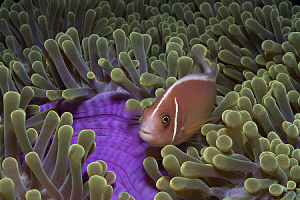
© Warner Bros. Pictures. A Crocodilefish hides among rocks
off the coast of Papua New Guinea.
Just north of Australia and the Coral Sea lies a vast region known as the Coral Triangle. Spanning several hundred miles, it encompasses the waters of Indonesia, Malaysia, The Philippines, Timor-Leste and Papua New Guinea, and extends as far as the Solomon Islands. It is home to approximately 40 percent of the world�s reef wildlife population, including more than 75 percent of documented coral species and some 3,000 individual species of fish, as well as sea turtles, mollusks, crustaceans and marine mammals such as dolphins and whales.
Says Michele, �The Coral Triangle is truly the center of biodiversity and a very significant area rich with ocean life. We were especially eager to explore and document it for the film.�
Once again, the filmmakers turned to IMAX as the most exciting and authentic way to bring their latest odyssey to life for moviegoers.
Howard attests, �Shooting with IMAX cameras can be enormously challenging because of the size and bulk of the gear and its complexity. But when you see those images projected in an IMAX theatre it�s a stunning experience, and there isn�t a director on earth who wouldn�t appreciate that. Once you have that opportunity, it�s hard to go back to a regular frame. The image quality is so precise, it�s virtually identical to what we experienced when we were down in the water�the same colors, the same texture, the same proximity. Even in 2D projection, the length and breadth of the frame is still IMAX. It makes you feel as if you could reach out and touch these animals�although in most cases, you wouldn�t want to!�
Adds Michele, �Often, I see things on the film that I didn�t see when I was diving. There�s one shot of a Giant Cuttlefish going after a crab, and it wasn�t until I watched the dailies that I noticed the detail of its eyes and skin.�
The Halls agree it�s this level of quality that makes the effort worthwhile. Altogether, production on "Under the Sea 3D" involved Howard and his crew each spending more than 350 hours underwater and 110 days at sea to capture almost ten hours of raw footage�not to mention the daunting task of transporting, loading, assemb ling and breaking down more than 8,000 pounds of equipment, including the 1,300-pound camera in its waterproof housing.
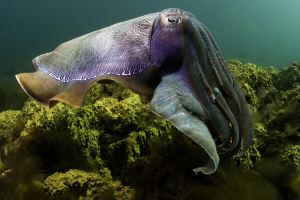
© Warner Bros. Pictures. A Giant Cuttlefish has the ability to show
the whole spectrum of color on his leathery skin. Which is good
for blending in and surviving.
Michele, who managed a great portion of the day-to-day logistics, including chartering boats for the dive team, laughingly recalls lo cal reaction to the state-of-the-art IMAX equipment. �I told people how big the camera was. I showed them pictures. I asked in advance for modifications to be made to their boats. But when we showed up with our 8,000 pounds of gear and the massive came ra, they�d just shake their heads and say, �We had no idea.� We tried to warn them, but they just didn�t believe it.�
Typically, there were four people underwater at any given time�Howard and cameraman Peter Kragh, plus two divers to assist with spotting and maneuvers. Three additional divers were dedicated to the launch-and-recovery protocol, lowering the camera into position or hoisting it topside for fresh film or new lenses, while Howard and the first team remained below to prepare their next shot. This way, those at the lower depths avoided multiple rounds of decompression and could, instead, remain in place for upwards of six hours at a stretch using closed circuit mixed-gas re-breathing apparatus that allows dives of much longer duration than traditional SCUBA tanks.
Meanwhile, on the boat, Michele and two camera assistants supervised the reloading of film and speedy return of the precious cargo to Howard�s waiting arms, aware that every minute�s delay could potentially cost them the best shots of the day.
In addition to the camera, Howard describes, �The tripod itself is 75 pounds. Then, to keep everything stable in the current, we usually put another 100 pounds of lead on top of that. Of course, these weights are relative underwater. When the camera is off the tripod, it doesn�t actually weigh anything. It�s neutrally buoyant. But it still has enormous mass, meaning that once it starts moving it doesn�t want to stop. And you certainly don�t want to be caught between the camera and a rock.�
Film rolls through the IMAX camera in double strips, simultaneously capturing left- and right-eye perspective on 15/70mm, making it the highest resolution camera in existence with the most sophisticated dual-strip technology. Its stereo 3D lenses are spaced to duplicate the distance between human eyes, with each lens recording the image received though each eye on the two corresponding film strips. Owing in part to this complexity, each dual roll of IMAX film records only 3 minutes. Consequently, the team did extensive preparation and location scouting before a single frame was exposed.
Howard outlines, �Our production schedule was quite long. The first year was spent doing homework, as well as visiting each location to make the dives, find the animals we wanted to spotlight and get a feel for the practicality of bringing the camera there.�
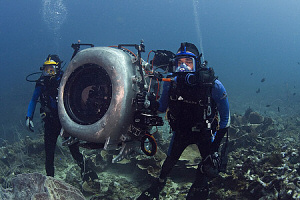
© Warner Bros. Pictures. Launch and Recovery Divers Dave Forsyth
and Richard Herrmann help to position the massive IMAX� 3D camera
in preparation for Director Howard Hall to capture his next shoot
in the South Coast of New Britain, Papua New Guinea.
Even so, their script was changing all the time. �We start with a very detailed plan and try to stick to it as much as possible but, frankly, sometimes the animals have other ideas,� he continues. �Often, they have better ideas. So the script gets changed on a continual basis as we progress through physical production, until I turn everything over to Toni Myers. We�re fortunate in that Toni is not only our producer but also our editor.�
Myers began her association with large-format filmmaking on the multi-screen documentary �Polar Life� and, most recently, directed the IMAX production �Space Station 3D.� She served with the Halls as producer and editor on �Deep Sea 3D� and was happy to rejoin them on their new excursion, proclaiming, �Howard is an absolute genius at capturing animal behavior and getting the most unique sequences I�ve ever seen. I don�t know how he does it because this is all in the wild. We have very specific action in mind, but there are always happy accidents.�
"Under the Sea 3D" marks executive producer Graeme Ferguson�s third collaboration with the Halls. A co-founder of IMAX Corporation, he first approached the documentarian when the company sought to produce its first oceanic feature. �I asked, �Who is the best underwater filmmaker in the world?�� Ferguson recalls. �It was Howard Hall. My job was then to persuade him to work in IMAX 3D and, fortunately, he accepted the challenge.�
For Ferguson, �The most interesting aspect of non- fiction is the same as it is with fiction: telling a story and having characters that hold your interest. Here, those characters are not people�they�re fish and octopi and other sea creatures�but they each ha ve their destiny and their purpose in life, too. And that�s the story we�re telling.�
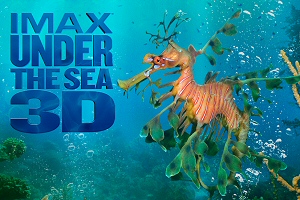
Finally, "Under the Sea 3D" needed a narrator who could give these stories the life and depth they deserve, as well as the humanity�a task entrusted to the multi-talented Jim Carrey. Says Howard, �Jim brings not only his dramatic capabilities to our narration but he has that essential humorous edge too, to bring out the parts of it that are very funny. There are a lot of fun and light moments in the film.�
Expeditions One and Two: Papua New Guinea
 Production Journal: April 4, 2008.
Production Journal: April 4, 2008.Today we really got lucky. I think we captured our best sequence so far�after nearly breaking all records for bottom time. It�s been a long day. This morning we took t he camera into the Mangroves. Sky was overcast. We need sun to shoot in the Mangroves but wanted to get in there and practice our camera moves when disturbing the bottom would not be an issue. As we were swimming back to the boat someone yelled down to us that Digger had found three Flamboyant Cuttlefish and that they were mating. We immediately donned re-breathers and were back in the water in five minutes. I climbed out 5.75 hours later.
Howard and his crew began their undersea exploration in January 2008 with the first of two separate visits to the islands of Papua New Guinea in the Southwestern Pacific Ocean. It is an area known for its beautifully lush coral reefs and the remarkable biodiversity of creatures that make the reefs their home.
Their first stop was Rabaul, on the island of New Britain. But, en route, they received word that a volcano was erupting on that exact spot, forcing them to adjust their agenda from day #1. Noting that their trip to Mexico for �Deep Sea 3D� had included an unscheduled greeting from Hurricane Javier, Howard took the blast in stride and captured the serendipitous volcanic action as their boat retreated from the island.
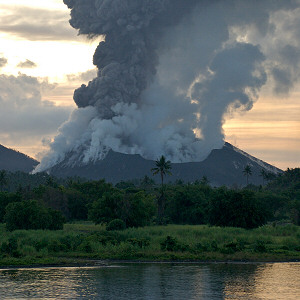
© Warner Bros. Pictures. An active volcano erupts, filling the
sky with ash and smoke just miles from where the crew was filming
the IMAX� 3D film Under the Sea 3D in New Britain, Papua New Guinea.
�The good news is that the film now includes footage of the eruption and a hail of ash,� says Michele.
Instead, the crew decamped to nearby Linden Harbor, on New Britain�s south coast. There, 15 days of diving, with Howard and his crew logging nearly 80 hours underwater in the largely unexplored reefs, yielded excellent exposure to a variety of rarely seen animals. Among them were a large Crown Jellyfish; a Wonderpus Octopus; and a new species of Lionfish, discovered only two years ago in Indonesia, happily feeding on smaller fish amidst the coral while the camera rolled.
Howard observed and filmed a devoted Frogfish couple courting; found an aggressive Tiger Mantis Shrimp�a species twice the size of its California cousins�spearing its dinner and quarreling with a Cardinalfish; and captured footage of an aptly named Crocodile Fish lunging directly at his lens in pursuit of an agile Blue Chromis (that got away), an action that is especially striking in 3D. During the second Papua New Guinea trip, to Milne Bay this time, he recorded a blue-spotted Stingray vigorously burying itself in the sand, and a rare glimpse of an Epaulette Shark, �a small shark that walks on the ocean floor using its fins,� found only in the Milne Bay area.
But the highlight of that trip was the discovery of two small male Flamboyant Cuttlefish courting a female. Says Howard, �It�s a very romantic dance. No one on board had ever seen a female of this species so large and never witnessed their courtship. To say that the cuttlefish colors are brilliant is an understatement; they are constantly changing.�
Expeditions Three and Four: Southern Australia and the Great Barrier Reef
 Production Journal: June 9, 2008.
Production Journal: June 9, 2008.No one saw the shark coming. It showed up out of nowhere. The moment Mark noticed the 15-foot beast it was four feet from my right ear. By the time I turned to see it, it was less than three feet away. That it got so close without us seeing it was very disquieting and certainly quite exciting. Of course, for something bad to have happened, it would have needed to be in the mood to bite something.
From New Guinea, the diving team traveled to points in Southern Australia and later to the Great Barrier Reef, the world�s largest coral reef system that forms a natural breakwater off the coast of Queensland. The Great Barrier Reef is home to some 2,800 species of sea life and 400 kinds of coral. Diving here is world-famous.
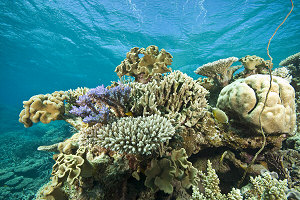
© Warner Bros. Pictures. A plethora of color can be seen in the healthy
hard coral reef at Challenger Bay in the Ribbon Reef complex of the
Great Barrier Reef of Australia during the filming.
They filmed several smaller varieties of shark while in Australian waters but the Great White was their prime quarry. With the help of famed shark attack survivor and marine conservationist Rodney Fox, the crew set up a protective cage and went in hunt of their stars in the North Neptune Islands.
Owing to the girth of the IMAX camera, Howard and cameraman Peter Kragh were unable to close the fourth side of the ir protective cage but, he explains, they felt safe in knowing that, �the shark would have to eat 1,300 pounds of aluminum before he ever got to us. Still, it wasn�t an average shark dive because we were often outside of the cage with the Great Whites, and that in itself was a rush.� The most vulnerable stage of the operation would be lowering the cage, camera, lights and weights into position.
The set-up caught the attention of five Great Whites, who circled numerous times during the three-hour dive, allowing for some excellent tracking shots and close-ups. Often they would turn so close to the lens it was impossible to film and once a shark collided so hard with the cage that it dislodged a tooth, which then floated gently and magically down to land in Howard�s open palm. A second dive yielded additional exciting close-ups, including a pair of 14-footers that approached so tightly and veered off so sharply that one brushed the camera port with its fin. But the moment no one will forget is when that one 15- footer suddenly materialized as the team was floating out of the cage and unaware.
In retrospect, Howard considers, �What we did was not without risk. That we clung so closely to the cage will seem over-cautious to some; that we left it at all will seem careless to others. One good thing about being a completely alien animal underwater is that nothing down there naturally feeds on you. Sharks don�t know what to make of humans; we�re not part of their normal diet.�
There are also venomous Sea Snakes to beware of, as well as jellyfish, stingrays and other potentially dangerous creatures. Michele cautions, �You must be careful as you touch down on the sea floor and always watch your hands and feet because you might get stung by something that wouldn�t ordinarily bother you but is defending its territory.�
In addition to the Great White encounter, underwater action in the Australian waters included Giant Stingrays spanning up to six feet in diameter, with venomous barbed tails, curious Dwarf Minke Whales that liked to swim in behind the camera and then dart away, and a variety of creatures whose fanciful names suggest what they look like: the Lined Butterflyfish, Bumphead Parrotfish and Potato Cod.
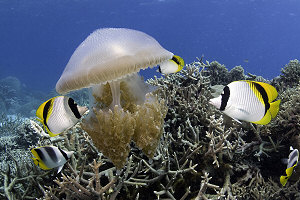
© Warner Bros. Pictures. The dance of the jellyfish (Thysanostoma thysanura) draws
the attention of several Butterflyfish (Chaetodon ulietensis) in the cool waters of Clam Gardens
in the Great Barrier Reef of Australia during the filming.
South Australia is home to the Giant Cuttlefish, kin to the Flamboyant Cuttlefish the Halls found in New Guinea but many times their size�in fact, the largest cuttlefish in the world�and every bit as colorful. Here they were also conducting courtship rituals but unlike the more light-hearted footage Howard gathered earlier, this group offered some fearsome and splendidly photogenic threat displays from competing males. �They pretty much fill the frame even when three feet away,� he says. �Their faces appear two feet across and their long tentacles should appear to reach out to touch a viewer�s cheek.� Days later, the director rounded out his sequence by overseeing a battle between a hungry cuttlefish and a feisty crab. No one was betting on the crab but he put up a good fight.
A 90-tentacled Chambered Nautilus that prefers cooler temperatures took the divers down to 155 feet on the Great Barrier Reef, a record depth for filming with the IMAX 3D camera. A representative of a diminishing species, the Chambered Nautilus in its lustrous shell is one of only six existing varieties of nautiloids that once numbered 2,000.
Howard also broke a record here for time logged underwater in a single dive, in his six-hour pursuit of the remarkably comical�but lethal�character called a Reef Stonefish, so named because it blends in with rock formations on the ocean floor in order to ambush its prey. A member of the Scorpionfish family, displaying what he affectionately calls �the ugliest face you�ve ever seen,� the Stonefish is the most venomous fish on the planet.
Two other masters of camouflage, tho ugh far less deadly, are the Leafy Sea Dragon and its cousin, the Weedy Sea Dragon. �They�re very gentle and fragile- looking animals, elegant and mysterious,� says Michele. �They live in kelp and are so well hidden that you could be staring at one and not even know it.�
�The Leafy Sea Dragons in particular look like something from science fiction,� offers Toni Myers, referring to the way in which these creatures resemble more vegetable than animal, with multiple leaf- life extensions that drift around their bodies as they glide through the water like bits of floating seaweed.
At Hopkins Island in South Australia, the divers were met by a friendly and highly photogenic group of Australian Sea Lions, among the most endangered of pinnipeds, numbering only approximately 12,000. Says Howard, �They are also among the most beautiful, with blonde fur and exceptionally expressive faces. They were so enthralled by their own reflections in the large IMAX housing lens port that we had to repeatedly shoo them away in order to photograph them.�
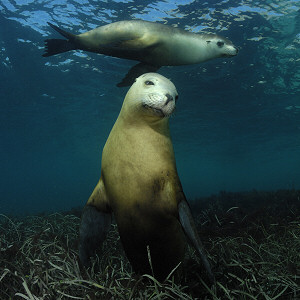
© Warner Bros. Pictures. A pair of Australian Sea Lions lazily cruise
the waters of the Hopkins Island in South Australia during the filming.
For Michele, �One of the best things for me in making this film was the opportunity to get into the water with the sea lions. As I was taking photos, I felt something and looked up to see one of them biting at my strobe. Granted, it was a wild animal, but I didn�t feel at all threatened. It was a very playful move.�
Less playful were the encounters captured between Green Sea Turtles and jellyfish. Unlike humans, the turtles are immune to the jellyfish�s venomous sting and apparently find the delicate animals delicious. Howard and his film crew spent hours closely chronicling three turtles voraciously feasting on their favorite meal.
Expedition Five: Indonesia
 Production Journal: October 3, 2008.
Production Journal: October 3, 2008.If someone had told me there was a place where Garden Eels rise more than six feet above the sand I would have thought the claim a gross exaggeration. But as I stood behind the IMAX 3D camera today, waiting hour after hour for the eels in front of the lens to come out, I could see eels in the hazy distance that were taller than me, by at least a foot! This enormous field of eels surrounded us as far as we could see in any direction.
The last leg of their journey took the crew northward to the waters around Indonesia in the Coral Triangle and �some of the most isolated reefs in the world,� says Howard. �Our primary goal was to capture the breathtaking colors of the reefs in the Coral Triangle.� Additionally, they investigated the roots of the coastal Mangrove forests where they extend into the shallow water and provide shelter and feeding grounds for numerous small fish.
That accomplished, they turned their attention to the eel population, getting what the director estimates as �the most intimate look at Garden Eels every captured on film.� Contrary to their name, these were hardly garden- variety eels; they were giants. Initially shy about the lights, they retreated into their burrows as soon as they were approached, requiring the dive team to bide their time for hours until they re-emerged. But getting footage of so many enormous eels swaying gracefully in the current was worth the wait.
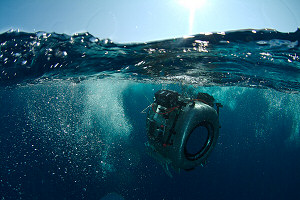
© Warner Bros. Pictures. The massive IMAX� 3D camera makes waves of its own
as it plunges into the waters of Indonesia on another shoot.
Wrapping up their exploration, the team continued to log one fascinating image after another: a rarely photographed honeycomb Moray Eel with black spots, schools of Striped Catfish, yellow and black Ribbon Sweetlips, Skunk Anemonefish and even some oceanic slapstick of a small Carrier Crab hoisting a complacent Cassiopeia Jellyfish onto its back and ambling away.
Change One Element and the Whole System Is Affected
One of the points "Under the Sea 3D" illustrates is how these species are interconnected�with each other and with their habitats�and evolved in ways that make it possible for them to live and thrive.
Small, agile fish known as Cleaner Wrasse get their meals by grooming dead skin and parasites from the mouths and gills of larger carnivorous species. The larger fish, in turn, refrain from eating the Wrasse because they value the service. Keen-eyed gobies often share their dens with shrimp, which are blind but are excellent burrowers. Staying close to the goby, shrimp are warned of approaching predators; meanwhile, they employ their digging skill to enlarge the goby�s home. The coral reef, itself alive, provides a refuge for many animals, as well as a hunting ground for food and a place to spawn.
As Howard observed in �Deep Sea 3D� and reiterates here, �If you remove one element from the mix, things change. Remove several things and the system collapses.
�It�s a complicated situation,� he grants. �There are many issues affecting the coral reef. Industries, especially in the Third World, have a major impact. There�s a lot of benefit to people from that kind of development but there is also a benefit to people to have the coral reefs and not to allow them to die off.
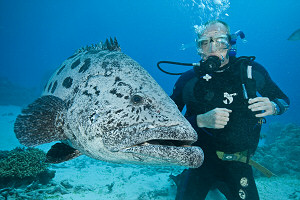
© Warner Bros. Pictures. One of the Under the Sea 3D film crew, Stuart MacFarlane,
poses for a photo next to a giant Potato Cod (Epinephelus tukula)
as it shows off its potato-like markings in the Great Barrier Reef of Australia.
�One of the things affecting coral reefs on a worldwide scale, and especially the Coral Triangle region where you have the greatest biodiversity, is climate change�specifically the increase in carbon dioxide levels in the atmosphere. Not only does carbon dioxide create the greenhouse effect that causes global temperatures to increase, but it also dissolves into sea water, altering its chemistry from alkaline to more acidic. It�s not a big change, but it affects some very important chemical reactions. Most importantly, it hinders the formation of calcium carbonate, and calcium carbonate is what makes the coral reefs themselves, as well as the shells of animals like mollusks, clams, and the Chambered Nautilus,� he explains.
�If these chemical changes become too dramatic because carbon dioxide levels rise too high, coral reefs could begin to dissolve and many animals would be unable to form shells, and that could have a devastating effect on ocean ecology worldwide.�
Filming Challenges: Well Worth the Effort
 Production Journal: January 11, 2008.
Production Journal: January 11, 2008.No matter how carefully you might plan, anticipating every imaginable contingency, nature often has a way of sending a large white pelican soaring high overhead to drop an enormous deposit of wet and pungent humility right on top of your head.
No pun intended, but securing the best possible footage of this underwater panorama requires, foremost, an ability to go with the flow.
�Animals have free will. Some days are great, and others are utterly useless,� Howard acknowledges. Often, creatures he planned to film during a period that should have been their standard mating or feeding time did not exhibit the expected behavior. They shied from the dive crew and, regardless of how long he and his colleagues patiently waited, simply did not return. Locations that had teemed with life during scouting dives mere months ago could be curiously calm on a second visit.
Unpredictable weather and shifting tides frequently produced currents so strong they nearly swept the camera away or completely obscured visibility. Above the water line, the boat was once engulfed by a swarm of bugs so dense it was impossible to reload film. Another time, following a successful session, the camera housing was opened to reveal a live moth that had been inexplicably trapped inside. It wasn�t until several anxious days later that Howard learned the insect had unfortunately spent most of its time on the camera port, right in front of the le ns, while the camera was running, and nearly ruined one of the team�s best sequences.
If the agenda was set for one animal but something rarer presented itself, the team would abandon Plan A in favor of the more cinematically promising show, hoping to capture their original subject later. �It�s impossible to know when the action happening in front of the camera is going to be an easy shot, reproducible any day of the week, or when catching a certain behavior on camera is a once-in-a-lifetime opportunity,� says Howard.
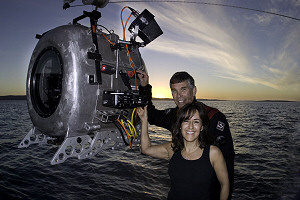
© Warner Bros. Pictures. Director Howard Hall beams after
another exhilarating shoot in Milne Bay, Papua New Guinea.
One typical day, the crew was focused on a Tiger Mantis Shrimp but, he recounts, �After an hour of false starts, it closed its den and went to bed.� They turned, instead, to a Wonderpus Octopus, and didn�t emerge from the water until six hours later. At that point, the director had showered, dismantled his diving equipment and was looking forward to dinner and some rest when �o ne of the guides surfaced to say there was a Tiger Mantis Shrimp out of its den and digging a new hole. This is very unusual. I had never seen this happen. So, we were back in the water 15 minutes later.�
In a lifetime of wildlife cinematography, he has learned to seize his opportunities. �It pays to be ready for anything. Sometimes you get a lucky shot. But you can�t get lucky unless you are down there trying.� Overall, the disappointing dives and wasted hours were far surpassed by exceptional action and moments of sheer exhilaration.
Says Howard, �I think everyone involved would agree that it has been well worth the effort. "Under the Sea 3D" is visually dazzling. Seeing, in IMAX 3D, the hard and soft corals surrounded by myriad species of fish in a way that is near virtual reality is an amazing experience. Audiences will not be cold and wet, but what they�ll see when they look through those goggles is exactly what we saw through the dive mask. It is my hope that there will be times they won�t know what they are looking at until it is in their laps.
�The most important thing I believe people will get from seeing this film, aside from being entertained, is that they will emerge with a sense that these places and animals are valuable and worth protecting. They�re part of our legacy.�
« Previous | 1 | 2 | 3 | 4 | 5 | Next »










